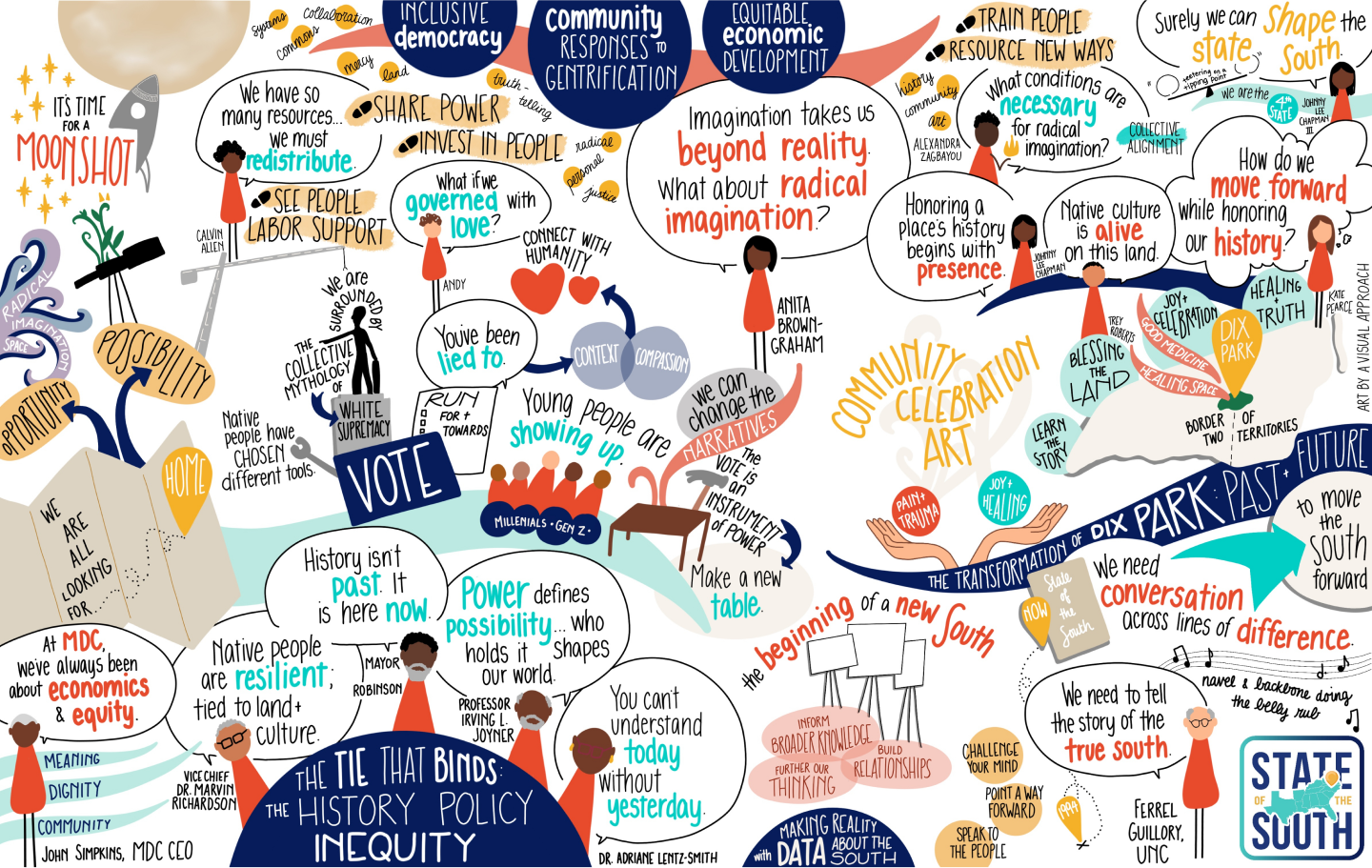This call to action presents a foundational set of recommendations grounded in our shared commitment to equity, inclusiveness, and the opportunity for all Southerners to thrive. While this is a starting point, we recognize it is incomplete. We look forward to engaging with leaders, research experts, and those with lived expertise to deepen our understanding and advocacy for the issues that create a South where everyone can thrive and achieve upward economic mobility.
To foster a South where individuals lead meaningful, self-determined lives, we must take bold steps to transform key systems that perpetuate inequality and exclusion:
Improve housing security and affordability through inclusionary zoning
We must embrace inclusionary zoning to dismantle historic patterns of segregation. By ensuring access to affordable housing near quality jobs, schools, and services, we create opportunities for lower-income households to thrive. Follow examples like Minneapolis, which boosted housing stock and affordability by eliminating single-family zoning and parking requirements. This strategy could be a blueprint for many Southern cities to simultaneously address housing and transit issues.
Stabilize income and reduce the racial wealth gap
Guaranteed income, baby bonds, and raising the minimum wage are critical policy tools to secure financial stability for the working poor and to bridge the racial wealth gap. These interventions provide immediate relief and long-term wealth-building opportunities, allowing Southerners to focus on building meaningful futures.
Cities can fund these efforts through creative approaches:
Minimum wage increases: Municipalities can increase revenue by leveraging local taxes, such as sales taxes on luxury goods or tourism-related taxes (e.g., hotel and entertainment taxes). Consider Seattle, a city where a more equitable funding structure was created to increase their minimum wage floor. This was achieved by adjusting the city’s business tax structure and ensuring corporations and larger employers contributed fairly.
Guaranteed income: Many cities have successfully implemented guaranteed income programs by securing philanthropic partnerships and redirecting funds from local economic development budgets. The funding provides direct cash payments to residents, helping them cover basic needs and invest in their futures. In some cases, pilots have moved to policy by codifying the process and funding sources to pay for guaranteed income programs, ultimately supporting the local economy.
Baby bonds: A baby bonds program could be funded by reallocating portions of tax revenue from high-net-worth property owners or implementing progressive taxes on real estate transactions. A few states and cities have funded their baby bonds initiative through state-level taxes, with the goal of providing every child born into low-income families with seed money for future investments in education or homeownership.
Expand Medicaid
Medicaid expansion is essential to ensuring all Southerners have access to necessary healthcare. States can address the healthcare coverage gap by expanding Medicaid to all low-income adults, as has been done successfully in many states. Medicaid expansion broadens access to healthcare, reduces the strain on emergency services, and prevents nonparents—those who often fall into the coverage gap where income is too high for Medicaid but too low for subsidies—from choosing between healthcare and other basic needs. Moreover, states should avoid tying Medicaid eligibility to work requirements. These requirements disproportionately harm vulnerable populations, such as individuals in low-wage or unstable jobs, caregivers, and people with health conditions. Research shows that such requirements do not increase employment but lead to coverage losses, exacerbating health disparities. Removing work requirements and expanding Medicaid can guarantee that more people, regardless of employment status, have access to essential healthcare services, contributing to healthier communities and long-term economic stability.
Redesign the Preschool-to-Grade 20-to Workforce (P20W) System to foster an inclusive, flexible, and community-centered approach to education
Adopt equitable funding strategies for education. Funding K-12 schools through local property taxes reinforces racial inequity because it perpetuates disparities rooted in historical segregation, particularly redlining policies. Since local property taxes are one of the primary sources of school funding, schools in wealthier, predominantly white neighborhoods receive more resources, while schools in lower income, often predominantly Black and Brown neighborhoods, remain underfunded. Separating property taxes from school funding and adopting needs-based funding can make certain every child has access to quality education, regardless of where they live.
To compensate for the loss of property tax revenue, states or the federal government can increase other taxes, such as taxes on the purchases of alcohol, cigarettes, and vaping products. A more equitable solution would be to tie a larger portion of school funding to state gross domestic product (GDP). In 2021, the national average of state GDP devoted to K-12 education was 3.3 percent, far below states like New Jersey, Vermont, and Wyoming, which devoted roughly 5 percent of their GDP to K-12 education during the same year.
Expand learning beyond the classroom with credit recognition: Schools should embrace “anytime, anywhere” learning by recognizing that valuable education takes place outside traditional classrooms. Work-based experiences, such as internships, apprenticeships, part-time jobs, after-school programs, service learning, and community projects, contribute to students’ skill development. States like Rhode Island and New Hampshire have adopted credit-for-learning approaches, allowing students to earn graduation credits for these out-of-school experiences. Implementing such policies across other states can improve student engagement, personalize learning, and better prepare students for college and careers by acknowledging their diverse learning paths.
Strengthen community and parental involvement: Education thrives when families and communities are actively involved. Schools should work alongside communities to define the purposes of education and establish a clear vision for what students need to succeed in adult life. Parents, caregivers, and other community members play a critical role in reinforcing learning outside the classroom and ensuring education remains relevant to local needs. Schools should invest in building strong partnerships with families and other stakeholders, as well as supporting media and policy groups in raising awareness about educational equity. These efforts will foster a sense of ownership and collaboration that drives meaningful improvements in student outcomes.
Adapt and strengthen data systems: While offering flexible learning opportunities is important, it’s equally crucial to prevent marginalized students from slipping through the cracks. Comprehensive and transparent data systems are necessary to track student progress and ensure that every student receives the support they need. Statewide longitudinal data systems—commonly referred to as P20W systems—track students from early childhood through their entry into the workforce. Texas’s Public Education Information Resource website and California’s Cradle-to-Career Data System serve as examples of how states can centralize data to monitor equity and outcomes. These data systems allow educators, families, and policymakers to make evidence-based decisions, ensuring that students’ needs are met throughout their educational journeys.
Support programs and policies to reduce student loan debt
Student loan debt relief benefits communities and local governments by increasing disposable income, which boosts local economies through higher consumer spending. For borrowers, reduced debt allows for greater financial stability, enabling them to invest in housing, education, and small businesses. This relief also improves economic mobility in the South, where student debt disproportionately affects low-income and minority communities, creating more opportunities for workforce participation, job retention, and long-term economic growth.
There are several ways to ease the burden of student loans to uplift all residents:
Educate and raise awareness about student loan debt resources: Engage local organizations, employers, and community leaders to become student loan debt resource ambassadors. For example, ambassadors for the North Carolina Student Debt Relief Coalition (NCSDRC) disseminate vital information about student loan debt relief programs, resources, and updates to their networks. This grassroots approach ensures all North Carolinians can access current debt repayment options and forgiveness programs.
Employer-based debt repayment programs: Educate and encourage employers to offer student loan repayment assistance through educational assistance programs, which can provide up to $5,250 annually, tax-free, for qualified loan payments. Historically, these programs have helped employees pay for books, equipment, supplies, fees, tuition, and other education expenses. However, due mainly due to the COVID-19 pandemic, employer educational assistance can now be used to pay principal and interest on an employee’s qualified education loans. Under the current law, the option to use educational assistance is available for payments made after March 27, 2020, and then can be used until December 31, 2025, pending any legislative changes.
Tax exemptions for forgiven loans: Advocate for states to exempt forgiven student loans from income taxes– aligning with federal exemptions– to prevent added financial strain on borrowers.
State-funded loan forgiveness: Expand state-funded loan forgiveness programs to include not only jobs in healthcare and education but also low-wage sectors, like retail and caregiving, to improve worker retention and economic mobility. Local governments can partner with businesses to support these efforts.
Address predatory lending
Often described as legalized robbery, predatory lending disproportionately affects low-income communities, particularly people of color, forcing them into cycles of debt. States can discourage these harmful practices by passing legislation that caps interest rates on payday loans and other high-interest lending products. This keeps money within local communities, rather than draining wealth through interest payments to out-of-state lenders. Supporting community-based credit unions and microlending programs can also provide safe, affordable loan options that allow individuals to build wealth rather than fall into debt traps.
Philanthropic organizations can fund research and awareness campaigns to inform the public and policymakers about the negative impacts of predatory lending. They can build coalitions of actors, like the Southern Partnership to Reduce Debt, to change policies and practices that systematically strip wealth from marginalized communities.
Southern states can embrace unions, improve wages, and create diverse, community-driven economic development, leading to greater prosperity and dignity for all workers.
Improve wages and worker protections
Southern states and workers can build strong unions by looking to successful examples throughout the country. One strategy is to challenge “right-to-work” laws, which allow those in unionized workplaces to opt out of paying union dues and fees. By building coalitions with local advocacy groups and elected officials, Southern workers can push for pro-labor legislation to strengthen their collective bargaining rights. This approach has been successful in Michigan, where recent legislative changes have expanded resources for workers to organize. Philanthropic organizations can support collective bargaining efforts and policy changes by providing financial resources (ex. The LIFT fund), fostering partnerships, and advocating for workers’ rights.
Practices such as raising the minimum wage, providing paid sick leave, and enforcing fair labor standards can greatly improve Southern workers’ wellbeing. In states like Washington and Oregon, strong labor protections have contributed to higher wages and reduced worker exploitation. Southern states can adopt similar policies by advocating for higher, inflation-indexed minimum wages and offering government-funded legal support for labor disputes, particularly in industries like agriculture, care, and domestic work, which often exploit immigrant labor.
Many local governments are enacting legislation and practices to improve worker protection. For example, local governments have established ongoing Wage Boards or Worker Councils to give workers a formal role in local government and/or access to local officials and agencies. In addition, localities have focused on passing local worker protection laws, including ordinances regarding minimum wages, paid sick leave, fair scheduling and industry-specific protections for sectors with high violation rates or specific vulnerability (such as the domestic worker, gig, hotel, retail, fast-food and freelance industries).
Raise awareness about labor exploitation and workers’ rights:
- Use storytelling to connect consumers emotionally to the real-world challenges faced by workers. Highlight personal narratives from farmworkers, domestic workers, and others in exploited industries, using platforms like social media, podcasts, or video series. Leverage campaigns like the Coalition of Immokalee Workers’ (CIW) Campaign for Fair Food to demonstrate the direct impact of consumer choices on labor conditions.
- Highlight the role of alt-labor groups in policy victories that have transformed labor environments across the U.S.
- Encourage consumers to support businesses that have signed labor protection agreements.
- Develop easy-to-access resource templates for workers, like sample contracts for domestic workers that outline employment expectations.
- Educate consumers and state governments in the South on established bills of rights in other parts of the country – especially how groups have created bills of rights for domestic and temporary workers—to inspire a deeper commitment to ending exploitation.
Raise awareness about immigration reform strategies
Immigration reform strategies that offer a clear pathway to legal status for undocumented workers can further enhance worker protections and contribute to state economic growth. Nonprofits can educate immigrant workers about worker protections, such as the ability to join unions, without fear of deportation. Legalizing undocumented workers and providing them with labor rights would increase tax revenue, boost consumer spending, and raise state GDP. For example, research from California and Texas has shown that legalizing undocumented workers results in higher wages, greater job security, and an increase in economic output. Southern states can replicate these strategies to protect immigrant workers while also enhancing their economic potential.
Adopt equitable approaches to community economic development
For economic development to be truly inclusive, Southern states need to invest in local assets and industries that benefit the community. This can be achieved through place-based development strategies that focus on each region’s unique strengths. In addition to the example from Eastern Kentucky shared in this report, other cities have focused on local assets and skills to improve workforce outcomes that allow people to share in the growth of their local economies. Consider Pender County, North Carolina, which has positioned itself as a logistics hub, while Chattanooga, Tennessee, has developed its tech and startup ecosystem by investing in a fiber network and sponsoring remote work pre-pandemic. These efforts have attracted investment and ensured that the benefits of economic growth remain within the community. States and regions should also prioritize worker-owned cooperatives, which keep profits local and provide opportunities for broad-based wealth-building, ensuring economic resilience and sustainability.
Southerners have the power, resilience, and desire to shape their communities’ future political and economic direction. But this can only happen if we actively work to dismantle barriers to belonging, address economic and racial inequities, and ensure that every voice matters and every person belongs.
Foster inclusive decision-making
Policies must reflect the needs of the communities they affect. Engage community leaders, particularly those from underrepresented groups, to ensure their perspectives shape the region’s future. Decision-making processes should prioritize transparency and accessibility for all.
In cities like Greensboro, NC, participatory budgeting allows residents to decide how to allocate public funds. Expanding this model into climate adaptation projects would ensure that local communities, particularly those vulnerable to climate change, have a say in allocating resources for resilience projects, such as flood protection or heat mitigation strategies.
In many cases, rural Southern communities often rely on mutual aid and local networks for disaster recovery. By formalizing these networks into decision-making bodies where nonprofits work alongside agencies and philanthropy, communities can better advocate for resources and policy changes that reflect their needs. For example, Alabama’s Black Belt Citizens Fighting for Health and Justice has mobilized rural residents to fight pollution and climate change impacts through inclusive, community-led advocacy.
Tackle historical inequities in philanthropy
To support community belonging and equitable voice in decision-making, funders must begin by acknowledging the historical traumas and disparities faced by communities of color. They should align their actions with values that promote equity, moving beyond superficial commitments to tangible systemic change. This includes engaging in bold, intentional conversations with peers and board members and advocating for racial justice. Intentional investments should prioritize resources toward leaders and organizations that have lived expertise reflective of the communities they serve, ensuring they are empowered to lead transformative change.
Funders must also commit to equitable investments by leveling the playing field for historically underfunded organizations, offering multi-year funding to ensure long-term sustainability. Providing platforms for leadership development and policy influence will further support systemic change, while partnership fundraising can foster collaboration and risk-sharing. Finally, ensuring transparency and diverse leadership within boards will enhance trust and authentic community transformation, enabling funders to work alongside grantees in a shared mission for change.
Engage artists in the fight for equity in the South
How do we engage more Southerners in the fight for equity as a shared Southern value? What’s the spark that will light the fire for change? Find the activation point and be creative with your engagement process. It could be powerful data that illustrates the need for change or evocative storytelling that resonates deeply with people’s lived experiences.
As Johnny Lee Chapman III reminded us during our Durham State of the South™ event, maybe it’s art: “If you give artists a seat at the table from the beginning, you’ll get ideas that lead to innovative policy and infrastructure change. Never forget art when you’re thinking about what to do next.”
Consider letting muralists transform blank walls into vibrant canvases that tell the stories of their communities. Cities like Oakland, California and New Orleans, Louisiana have beautiful and expressive visual depictions of their respective communities. These artists beautify neighborhoods, while creating visual dialogues about social justice, challenging inequities, and celebrating cultural identities. By engaging with local artists, local governments and businesses create platforms for community voices, allowing them to weave together narratives that drive home the urgent need for systemic change.
We hope this report activates and inspires you to build a thriving South by joining our fight for systemic change. The path forward requires bold actions: expanding housing access, stabilizing incomes, securing healthcare, reforming education, and promoting worker protections. Just as critical are the efforts to foster inclusive decision-making, ensure belonging, and challenge the historic inequities that have defined our region for far too long.
By dismantling these barriers and building communities rooted in equity, dignity, and shared prosperity, we will create a future where all Southerners can lead meaningful, self-determined lives. The work ahead is not just necessary—it is urgent. Now is the time to act. Together, we can transform the South into a place where every person, regardless of race, background, or income, has a voice in shaping its future.

Authored by MDC
MDC envisions a South where all people thrive. We work with partners to strengthen community capacity, foster collaboration, and build influence to challenge systemic inequities and build an equitable and inclusive South.



